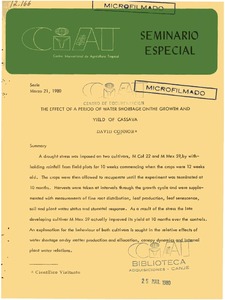The constitution was ratified by 67% of voters.
Search results
Showing items 1 through 9 of 34.-
Library ResourceConstitutionDecember, 1980Chile
-
Library ResourceConstitutionDecember, 1980Guyana
The constitution was adopted by Parliament.
-
Library ResourceReports & ResearchDecember, 1980Central America, South America
-
Library ResourceJournal Articles & BooksDecember, 1980Colombia, South America, Central America
-
Library ResourceConference Papers & ReportsDecember, 1980Peru, Colombia, Bolivia, Venezuela, Ecuador, Central America, South America
Data are given of area planted to beans, production, and yields in the Andean countries during 1964-66, 1974-76, and 1978; production, trade, and consumption during 1963-65 and 1973-75; and production, area, and yield growth rates during 1966-76. Constraints for bean productivity, cropping systems, and the main bean types consumed in the Andean countries are indicated. Finally, the potential of this crop is analyzed and data of land use and population patterns in the Andean countries are included. (CIAT)
-
Library ResourceJournal Articles & BooksDecember, 1980Colombia, South America, Central America
Drought stress was imposed on 2 cassava cv. (M Col 22 and M Mex 59) at Santander de Quilichao (Colombia), by withholding rainfall from field plots (plastic covers were placed over the soil surface) for 10 wk, commencing when crops were 12 wk old. The plants were then allowed to recuperate until the expt was terminated at 10 mo. Harvests were taken at intervals through the growth cycle and were supplemented with measurements of fine root distribution, leaf production and senescence, soil and plant water status, and stomatal response. As a result of the stress, the late-developing cv.
-
Library ResourceJournal Articles & BooksDecember, 1980Venezuela, Brazil, Central America, South America
Different nutritional deficiencies or toxicities may limit bean development and yield. N and P deficiencies are the most frequent, although deficiency of minor elements and Al/Mn toxicity can reduce yields considerably. Nutritional problems are usually diagnosed by soil and plant tissue analyses and the observation of symptoms produced by nutritional disorders. Optimum pH for bean production varies between 6.5-7.5; within these limits, the majority of the plant nutrients have their max availability. Color illustrations are given of the symptoms of plant deficiencies and toxicities.
-
Library ResourceJournal Articles & BooksDecember, 1980Colombia, Central America, South America
The progress achieved by CIAT's cassava program through training activities related to the crop in Latin America, Asia, and Oceania are given. In collaboration with the training office at the Centro Internacional de Agricultura Tropical, the cassava program in 1980 trained 38 professionals from 15 countries (Brazil, Colombia, Mexico, Bolivia, USA, Thailand, Dominican Republic, S. Africa, Ecuador, Haiti, Honduras, W. Germany, the Netherlands, Great Britain, and Italy).
-
Library ResourceJournal Articles & BooksDecember, 1980Colombia, Central America, South America
The progress achieved by CIAT's cassava program through training activities related to the crop in Latin America, Asia, and Oceania are given. In collaboration with the training office at the Centro Internacional de Agricultura Tropical, the cassava program in 1980 trained 38 professionals from 15 countries (Brazil, Colombia, Mexico, Bolivia, USA, Thailand, Dominican Republic, S. Africa, Ecuador, Haiti, Honduras, W. Germany, the Netherlands, Great Britain, and Italy).
-
Library ResourceJournal Articles & BooksDecember, 1980Peru, Colombia, Argentina, Mexico, Brazil, Central America, Northern America, South America
White mold, caused by the fungus Sclerotinia (Whetzelinia) sclerotiorum, is distributed worldwide and has more than 300 hosts. It infects flowers, cotyledons, seeds, leaves or injured plant tissue. The disease can be controlled by crop rotation, flooding, reduced seeding rates, application of chemical products in the middle of the flowering period, modifying plant architecture and the use of resistant var. Many soil microorganisms are associated with sclerotia and may cause them to degrade or fan to germinate. The symptoms and damage caused by the disease are illustrated in color.
Land Library Search
Through our robust search engine, you can search for any item of the over 64,800 highly curated resources in the Land Library.
If you would like to find an overview of what is possible, feel free to peruse the Search Guide.





